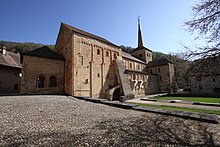Romainmôtier Monastery
The Romainmôtier Monastery is a former Benedictine monastery in the Swiss municipality of Romainmôtier-Envy .
history
According to a legend , the monastery was founded in the middle of the 5th century by St. Romain , the "father of the Jura" from Saint-Claude (France). It would be the earliest founding of a monastery on Swiss soil. This first monastery was destroyed by the Alemanni in the middle of the 6th century . Félix Chramnélène founded a second abbey in 632 according to the rules of Saint Columban . In 753 Pope Stephen II visited the abbey and submitted it directly to the Holy See. This is how it got the name “Romanum monasterium” - according to other sources, however, the name comes from St. Romain. Since then the monks have lived according to the Benedictine rules of the order. In spite of this, the abbey subsequently sank into a monastery owned by the kings of Burgundy , which they handed over to the reformed monastery of Cluny in 928/29. From that time on Romainmôtier had the status of a priory, it was not until 1447 that it received the title of an abbey again. Nevertheless, the monastery was still from King Rudolf III. made extensive donations from Burgundy and later from wealthy Vaudois families.
These donations marked the beginning of a heyday of the monastery, which lasted until the 15th century. As a result, a new church was built in Romanesque style by 1027 based on the model of the second abbey church in Cluny .
After Romainmôtier fell under the influence of the Dukes of Savoy in the 13th century, the abbey began to decline. From now on only favorites of Savoy received the office of prior. After Bern had conquered Vaud , the monastery was closed in 1536. The reason for the immediate secularization was probably the close ties with Savoy, the enemy of Bern. As a result, the cloister and the convent buildings, with the exception of the prior house, were demolished, and the monastery church was converted into a reformed parish church in 1537.
buildings
The collegiate church of Romainmôtier was built in the period from around 990 to 1030 and has survived almost unchanged to this day. It is considered to be one of the oldest buildings in Switzerland in the Romanesque style. The basilica has a cross-shaped floor plan: a three-aisled nave with a transept and a crossing tower with a flat pyramid roof that ends in a pointed needle helmet (put on in the 15th century). The original three apses are no longer preserved; they were replaced by rectangular Gothic chapels in the 14th and 15th centuries . One of them has an octagonal oriel tower. The entrance area was added in the 14th century.
Inside the collegiate church contains an ambo (early form of the pulpit) of the previous building from the 8th century. Also noteworthy are the reclining tomb of Prior Henri de Siviriez (14th century), the grave of Prior Jean de Seyssel, frescoes from the 14th century and the choir stalls from the 15th century. Remains of the former cloister are visible on the south side of the church.
The prior house, which dates from the 13th century, served the Bernese Vogt von Romainmôtier as the official residence and palace after the secularization of the monastery. It underwent some renovations in the 16th and 17th centuries. After the fall of the Ancien Régime, the castle was converted into a weaving mill and a wagon and several apartments were set up. The buildings, which had become dilapidated over time, were restored in the 20th century under Katharina von Arx . Today the former prior house houses a meeting center for artists.
literature
- Brigitte Pradervand, Nicolas Schätti, Philippe Jaton: The former Romainmôtier monastery church. (Swiss Art Guide, No. 814/815, Series 82). Ed. Society for Swiss Art History GSK. Bern 2007, ISBN 978-3-85782-814-0 .
Web links
- Official website of the municipality of Romainmôtier-Envy
- Germain Hausmann: Romainmôtier (monastery). In: Historical Lexicon of Switzerland .
- Website for the 1000th anniversary of the abbey
- Aerial photography
Coordinates: 46 ° 41 ′ 36 " N , 6 ° 27 ′ 41" E ; CH1903: 525 251 / 171813







